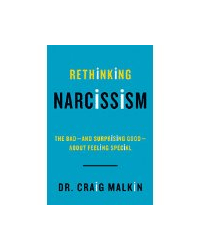“Rethinking Narcissism: The Bad – and Surprising Good – About Feeling Special”

“Rethinking Narcissism: The Bad – and Surprising Good – About Feeling Special”
By Craig Malkin
Harper Collins Publishers
New York, N.Y., 2015
Book explores many dimensions of narcissism
Reviewed by James K. Luiselli, Ed.D., ABPP, BCBA-D
The Diagnostic and Statistical Manual of Mental Disorders-5th Edition” defines narcissistic personality disorder as a pervasive pattern of grandiosity, need for admiration and sense of entitlement.
People with this disorder are interpersonally exploitive and consider themselves unique relative to the general population. They also lack empathy for the feelings of others, behaving condescendingly and with a patronizing attitude.
In “Rethinking Narcissism,” psychologist Craig Malkin looks at the clinical features of narcissistic personality disorder but also examines more subtle terrain.
Healthy narcissism, he argues, can be life-fulfilling “by inspiring our imagination and sparking a passion for life, open up our experience and expand our sense of our own potential.”
In his view, healthy narcissism “balances our own self-interests with other people’s needs,” a characteristic that should be cultivated and not maligned.
Malkin acknowledges that he was the son of a narcissistic mother, which powerfully influenced his view of the world. He sought to understand narcissism in greater detail during college and beyond, eventually making it a specialty area of professional practice.
This book is a wide-ranging account of research into narcissism, Malkin’s opinions about coping with the condition and his personal reflections.
The basis of narcissism, Malkin contends, is a normal human tendency: the drive to feel special. Narcissism is “a habit people use to comfort themselves” when faced with insecurity and other life challenges.
He concludes that “Narcissists bury emotions like fear, sadness, loneliness, and shame because they’re afraid they’ll be rejected for having them.”
A main tenant of the book, indeed its central theme, is that narcissism exists along a spectrum. The low end of the spectrum includes people who never enjoy feeling special, while the high end of the spectrum defines individuals befitting narcissistic personality disorder. The mid-range of the spectrum covers the healthy narcissism for which most people should strive.
Malkin and several colleagues created an assessment tool called the Narcissism Spectrum Scale that he reproduced in the book in abbreviated form with a simplified scoring system.
The reader is urged to take the test and compute a score that falls on the narcissism spectrum. A very large part of the book then advises how you should interpret your score, adjust accordingly and deal with the narcissistic behavior of friends, family members, colleagues, and bosses.
Having worked and interacted previously with full-blown narcissists, I was excited to read this book. It will certainly interest anyone who is intrigued about narcissism, what it means, where it comes from and Malkin’s contention about “the bad and surprising good about feeling special.”
There are numerous case descriptions throughout, illustrating clients at different points on the narcissism spectrum Malkin has treated and the therapeutic techniques he used with them. However, the book mostly falls within the self-help genre section of your favorite bookstore.
Psychologists and other mental health professionals curious about the book will find that Malkin writes from a psychodynamic perspective. His personal Web site listed in the book informed me that be believes in an unconscious mind, is influenced by relational psychoanalysis and practices as an “integrationist.”
And yet, his empiricist side shines through when he writes, “Stripped down to its basic action, narcissism is a learned response that is a habit and like any habit, gets stronger and weaker depending on the circumstances.”
So, this book explores the topic of narcissism along many dimensions, some more easily interpreted than others, sometimes persuasively but less compelling at other times.
There is little doubt that Malkin is passionate about studying narcissism as a human quality and dissecting its many manifestations in daily life. Referencing the narcissism spectrum he proposes, this book needs to be read carefully to fully grasp the author’s beliefs about narcissism and his judgments of whether it is destructive, has little impact or lies somewhere in the middle.
James K. Luiselli, Ed.D., ABPP, BCBA-D, is Chief Clinical Officer, Clinical Solutions, Inc. and North East Educational and Developmental Support Center, Tewksbury, Mass.
Learn more about the book: Rethinking Narcissism: The Bad-and Surprising Good-About Feeling Special

December 30th, 2019 at 6:50 pm Thomas A. Tashjian, Ph.D. posted:
Thomas A. Tashjian, Ph.D. posted:
I have to warn that it is a slippery slope to attribute behavior to any diagnosis. We have worked for years to de-stigmatize mental illness. There are highly productive and also dangerous people of every personality & cognitive type. As people are trying to define mental illness as a criteria to restrict people rights via gun control, we should remember Thomas Szaz warnings about that in the “Myth of Mental Illness”. I can think of cognitive factors that better explain the President’s rumination about perceived affronts, poor pragmatic skills, impulsive behavior ,stereotyped gestures & persistent rationalization / externalization to support denial of responsibility. Even so, there are very productive as well as very dangerous individuals with verbal & nonverbal cognitive structures that might lead to such traits.the most dangerous of antisocial people are the best rationalizers SO relieving themselves of personal responsibility. Are we modelling & so enabling such cognitive defenses for “bad actors” when we use a diagnosis to explain harmful behavior?